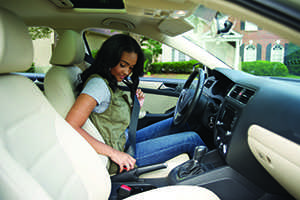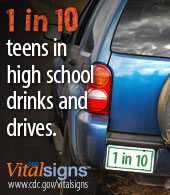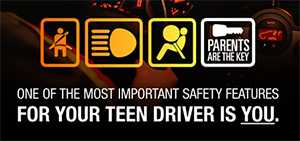Publications
Characteristics of Single Vehicle Crashes with a Teen Driver in South Carolina, 2005-2008

This study reveals that in South Carolina, when teen drives crashed while transporting teen passengers, the passengers were >5 times more likely to all be restrained if the teen driver was restrained. Crashes were twice as likely to result in serious injury when teen passengers were present than when the teen driver was alone. The report also highlights the need for surveillance systems that link crash data with health outcome data to more fully understand the circumstances and consequences of teen driver nonfatal crashes and evaluate the effectiveness of strategies to improve teen driver safety.
CDC Vital Signs
Motor Vehicle Crash Deaths
Reducing motor vehicle crash deaths was one of the great public health achievements of the 20th century for the US. However, more than 32,000 people are killed and 2 million are injured each year from motor vehicle crashes. In 2013, the US crash death rate was more than twice the average of other high-income countries. In the US, front seat belt use was lower than in most other comparison countries. One in 3 crash deaths in the US involved drunk driving, and almost 1 in 3 involved speeding. Lower death rates in other high-income countries and a high percentage of risk factors in the US suggest that we can make more progress in reducing crash deaths. (July 6, 2016)
 Teen Drinking and Driving
Teen Drinking and Driving
The percentage of teens in high school who drink and drive has decreased by more than half since 1991,* but more can be done. Nearly one million high school teens drank alcohol and got behind the wheel in 2011. Teen drivers are 3 times more likely than more experienced drivers to be in a fatal crash. Drinking any alcohol greatly increases this risk for teens. (October 2, 2012)
Journal Articles
- Shults RA, Bergen G, Smith TJ. Characteristics of Single Vehicle Crashes with a Teen Driver in South Carolina, 2005–2008. J Safety Res 2017
- Shults RA, Williams AF. Trends in teen driver licensure, driving patterns and crash involvement in the United States, 2006–2015. J Safety Res 2017;62:181–184. DOI:10.1016/j.jsr.2017.06.013.
- Jewett A, Shults RA, Bhat G. Parental perceptions of teen driving: Restrictions, worry and influence. J Safety Res 2016;59:119-123; DOI:10.1016/j.jsr2016.09.003.
- Shults RA, Haegerich TM. Bhat G. Teens and seatbelt use: what makes them click? J Safety Res 2016;57:19–25; DOI:10.1016/j.jsr.2016.03.003.
- Haegerich TM, Shults RA, Oman RF, Vesely SK. The predictive influence of youth assets on drinking and driving behaviors in adolescence and young adulthood. Primary Prev 2016; 0: NA. DOI 10.1007/s10935-016-0418-7.
- Shults RA, Banerjee T, Perry T. Who’s not driving among U.S. high school seniors: a closer look at race/ethnicity, socioeconomic factors and driving status. Traffic Inj Prev 2016; DOI: 10.1080/15389588.2016.1161761
- Shults RA, West BA. ATV riding and helmet use among youth aged 12–17 years, United States, 2011: Results from the YouthStyles Survey. Inj Prev 2015 Feb;21(1):10–14.
- Shults RA, Williams AF. Trends in driver licensing status and driving among high school seniors in the United States, 1996–2010. J Safety Res 2013;46:167–170.
MMWR Articles
- Shults RA, Williams AF. Graduated Driver Licensing Night Driving Restrictions and Drivers Aged 16 or 17 Years Involved in Fatal Night Crashes — United States, 2009–2014. MMWR Morb Mortal Wkly Rep 2016;65:725–730. DOI: http://dx.doi.org/10.15585/mmwr.mm6529a1.
- Sauber-Schatz EK, Ederer DJ, Dellinger AM, Baldwin GT. Vital Signs: Motor Vehicle Injury Prevention — United States and 19 Comparison Countries. MMWR Morb Mortal Wkly Rep. ePub: 6 July 2016. DOI: http://dx.doi.org/10.15585/mmwr.mm6526e1
- Shults RA, Olsen EO, Williams AF. Driving among high school students — United States, 2013. MMWR 2015; 64: 313-317.
Additional Resources
 Parents Are the Key to Safe Teen Driving
Parents Are the Key to Safe Teen Driving
Parents Are the Key, a campaign from the Centers for Disease Control and Prevention (CDC), helps parents, pediatricians, and communities keep teen drivers safe on the road.
Reducing Risks for Teen Drivers 
Safe Kids Worldwide report “Reducing Risks for Teen Drivers” examines trends in motor vehicle crashes involving teens, and explores how families are managing the risks new drivers face.
- Page last reviewed: August 1, 2017
- Page last updated: August 1, 2017
- Content source:
- Centers for Disease Control and Prevention,
- National Center for Injury Prevention and Control,
- Division of Unintentional Injury Prevention


 ShareCompartir
ShareCompartir
